|
|
Dear colleagues
Conferences are a market place for the international exchange of ideas. One of my first, shaky, steps in the synchrotron world occurred at VUV 2001, the international conference on Vacuum Ultraviolet Radiation Physics in Trieste. Looking back at the conference webpage I found a picture of myself, not in a scientific session but on the boat to the conference dinner.
Indeed, apart from the scientific excitement, this conference dinner left a deep impression in my memory...
Read the full text of Frithjof Nolting below !
|
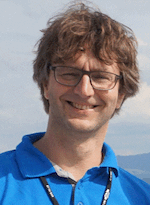
Frithjof Nolting
|
|
Next calls for proposals
SLS: PX-beamlines
deadline: October 15, 2016
SLS: non-PX beamlines
deadline: March 15, 2017
more information
SINQ
deadline: February 20, 2017 (attention: new date !)
more information
SLS/SINQ: joint X+N powder diffraction
deadline: February 15, 2017
more information
SµS
deadline: December 6, 2016
more information
An overview about all proposal submission deadlines of the PSI facilities can be obtained here.
|
|
|
Magnesium oxide boosts the hysteresis of single-molecule magnets
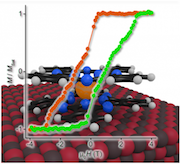 SLS - Molecular spintronics SLS - Molecular spintronics
Researchers from PSI and EPFL have demonstrated that the magnetization hysteresis and remanence of TbPc2 single-molecule magnets drastically depends on the substrate on which they are deposited. If a few atomic layers thick magnesium oxide film grown on a silver substrate is used, a record wide hysteresis and record large remanence can be obtained. Single-molecule magnets are attractive for molecular spintronics applications such as information processing or storage.
Read the full story
|
|
|
C. Wäckerlin et al, Advanced Materials 28, 5195 (2016)
|
|
|
Observing magnetic domains at work by neutron grating interferometry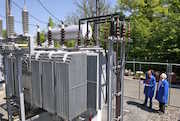
SINQ - En route to better transformers
Researchers at the Paul Scherrer Institute PSI have found a way of looking inside the iron core of transformers. Transformers are indispensable in regulating electricity both in industry and in domestic households. The better their iron cores are magnetized, the less energy they lose and the more efficiently they work. The groundbreaking investigatory method of neutron grating interferometry developed at PSI ...
Read the full abstract
|
|
|
B. Betz et al, Physical Review Applied 6, 024023 and 024024 (2016)
|
|
|
Physical realization of a quantum spin liquid based on a complex frustration mechanism
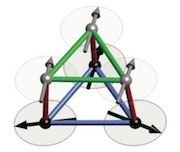 SμS - Spin liquids are possible in complex systems SμS - Spin liquids are possible in complex systems
Unlike conventional magnets where the magnetic moments are partially or completely static in the ground state, in a quantum spin liquid they remain in collective motion down to the lowest temperatures. The importance of this state is that it is coherent and highly entangled without breaking local symmetries. In the case of magnets with isotropic interactions, spin- liquid behaviour is sought in simple lattices with antiferromagnetic interactions that favour antiparallel alignments ...
Read the full abstract
|
|
|
C. Balz et al, Nature Physics, advance online publication (2016)
|
|
|
Catching proteins in the act
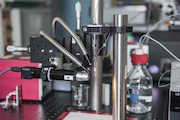 SwissFEL - Capturing ultrafast biological processes SwissFEL - Capturing ultrafast biological processes
Some of the fastest processes in our body run their course in proteins activated by light. The protein rhodopsin sees to it that our eyes can rapidly take in their ever-changing surroundings. Free-electron X-ray lasers such as SwissFEL at the Paul Scherrer Institute PSI now make it possible for the first time to catch such processes in flagranti. Free-electron X-ray lasers generate extremely short and intense pulses of X-ray light. Currently there are only ...
Read the full abstract
|
|
|
P. Nogly et al, Nature Communications 7, 12314 (2016)
|
|
|
DaaS: Data Analysis Service for SLS and SwissFEL
SLS
The volume of data and the requirements on hardware and software environments are steadily rising as new and more powerful X-ray detectors become available. To address these challenges PSI is building a data analysis service for SLS and SwissFEL that will go in production in 2017. Test users are already welcome now. More detailed information on the "Data Analysis as a Service" (DaaS) project can be found here.
|
|
SINQ - The First 20 Years - Scientific Colloquium on April 18, 2017
SINQ
Back in summer 1997 the first users performed their experiments at the Swiss spallation neutron source. Meanwhile more than 10000 user visits were counted and almost 1700 publications have been produced based on SINQ experiments. On the occasion of the 20th anniversary of SINQ operation a scientific colloquium will be organized at PSI on April 18, 2017.
The main developments and achievements at SINQ will as well be presented as actual hot scientific topics and the many international collaborations of SINQ. Invitations will be sent out during the next months - for the time being please save the date in your agendas.
|
|
Alex Amato new Head of the LMU
SμS
Dr. Alex Amato has been appointed as the new Head of the Laboratory for Muon Spin Spectroscopy LMU starting from November 1st, 2016. He will succeed Prof. Dr. E. Morenzoni due to his imminent retirement. Alex Amato started his work in muon spin spectroscopy in 1990 and joined PSI in 1996 as a beam line scientist, responsible for the General Purpose Surface-Muon Instrument (GPS). In 2004 he was appointed Head of the Bulk-μSR Group. Under his leadership several key developments have been performed. Besides a complete redesign of the GPS, GPD, and DOLLY instruments, the realization of μSR under extreme conditions (high pressure, high temperature, high magnetic field at very low temperatures) resulted in important and partially unique extensions to the μSR technique.
On the occasion of the retirement of E. Morenzoni, in the afternoon of October 13th, there will be a small symposium at PSI followed by an aperitif. A detailed program will be posted later. Users are cordially welcome.
|
|
First Free Electrons, first beam at 144 MeV and first acceleration with SwissFEL C-band modules
SwissFEL
From the end of August to mid of September 2016 a couple of important milestones were reached for SwissFEL. On the 24th of August 2016 the first free electrons were produced and accelerated to 7.9 MeV. On the 8th of September the first electrons were transported and accelerated in the SwissFEL injector beamline. At an estimated final beam energy of 144 MeV the shift crew managed to propagate the beam up to the injector beamdump at a distance of 120 m from the electron source. On the next day the 9th of September electrons were accelerated with a SwissFEL C-band module (the first one of a series of 26 modules) for the first time.
This is a great success and means that the first milestones for the SwissFEL beam commissioning were reached! Read more.
|
|
Editorial
Dear colleagues

Conferences are a market place for the international exchange of ideas. One of my first, shaky, steps in the synchrotron world occurred at VUV 2001, the international conference on Vacuum Ultraviolet Radiation Physics in Trieste. Looking back at the conference webpage I found a picture of myself, not in a scientific session but on the boat to the conference dinner.
Indeed, apart from the scientific excitement, this conference dinner left a deep impression in my memory. It was absolutely great, especially since it finished at about 2 am and I was the first speaker on the next day.
It was therefore a big honor and pleasure for me to co-chair VUVX 2016 in Zuerich, which is the successor conference after a merger of the VUV and the X-Conference meetings. Being a co-chair enabled me to ensure that, this time, it was not me who had to talk early in the morning after the conference dinner (sorry Thomas). Thanks to the help of many people and all the participants, this conference was very exciting with many stimulating talks and discussions.
While there are many modern communications tools, it is my view that an in-person meeting with your colleagues is still an indispensable ingredient for our scientific life. I am therefore looking forward to the next edition of the VUVX conference in 2019 in San Francisco.
For a more detailed report about the VUVX 2016 see the report from Liz Moxon here.
Frithjof Nolting,
head of the Laboratory for Condensed Matter and Materials Science LSC, SYN department, PSI
|
|
JUSAP - The Joint Users Association
The next few months promise to be full of activity.
Please note that the upcoming proposal deadline for SINQ has been shifted to February 20th, 2017, while that for SμS is December 6th, 2016.
The election of a new JUSAP committee will also take place this autumn electronically. The candidates will be visible on the JUSAP webpages.
|

Sarah Duninger
|
|
It is anticipated the incoming committee will convene for the panel meeting, which takes place biannually, in the autumn and spring of each year. We would like to ask the user community for their input, comments and concerns, as well as on their suggestions towards the future goals of JUSAP.
With best wishes for the future from the entire JUSAP committee.
Sarah Dunsiger (JUSAP committee chair)
|
|
Workshop on an accelerator based source for nonlinear THz science at SwissFEL
October 3, 2016, Windisch, Switzerland
Modern Trends in Neutron Scattering for Magnetic Systems and Single Crystal Diffraction with Polarized Neutrons
October 3-7, 2016, Tutzing, Germany
BESSY II Foresight Workshop on Energy Materials Research
October 10-11, 2016, Berlin, Germany
Workshop on SoNDe applications: Neutron detection in research and industry
October 17-19, 2016, Freising, Germany
NOBUGS 2016
October 20-21, 2016, Copenhagen, Denmark
BioCAT Advanced SAXS Training Course 2016
October 31 - November 3, 2016, Chicago, IL, USA
GISAXS 2016
November 16-18, 2016, Hamburg, Germany
New Trends in Magnetic Structure Determination
December 12-16, 2016, Grenoble, France
LiXS 2017: Liquid-Xray-Spectroscopy
January 17-18, 2017, Gif-sur-Yvette, France
12th Soleil Users' Meeting
January 19-20, 2017, Gif-sur-Yvette, France
HERCULES European School 2017: Neutrons and synchrotron radiation for science
February 27 - March 30, 2017, Grenoble, France
37th Berlin School on Neutron Scattering
March 2-10, 2017, Berlin, Germany
more events
|
|
|
|